AAC Goal Writing with Lauren Enders: Tools to Support Identification of AAC Learning Targets

 We’re ending the week with some wonderful resources shared by AAC expert, Lauren Enders. In her continuation of the Goal Writing series, she reviews some important tools that can help in determining which skills to target when writing goals for AAC learners.
We’re ending the week with some wonderful resources shared by AAC expert, Lauren Enders. In her continuation of the Goal Writing series, she reviews some important tools that can help in determining which skills to target when writing goals for AAC learners.
You can see other posts in this series using the links below.
AAC Goal Writing with Lauren Enders
::::::::::::::::::::::::::::::::::::::::::::::::::::::::::::::::::::::::::::
In the first post of this series, you learned that you are in good company if you find AAC goal writing to be intimidating. Thankfully, you were also assured that despite the learning curve, you CAN write meaningful goals for AAC learners given the right tips, tools, and guidance.
In the second post, you learned how the Four Communicative Competencies (Linguistic, Operational, Social, and Strategic) (Light et al., 1989, Light & McNaughton, 2014)) plus Psychosocial or Emotional Competency (Light & McNaughton, 2014, Blackstone and Wilkins, 2009) or Self-Advocacy (Kate Ahern, 2014) can be used to help determine which skill areas to target for AAC learners. You also gained access to a handy checklist that can be used to ensure that goals matter. Thanks for coming back for more information on goal creation for AAC learners! In this post, we’ll shift our attention to several tools that you can use to assess your AAC learner’s current skills and generate developmentally appropriate goals.
Tools to Support Identification of AAC Learning Targets (Goals)
When we set out to accomplish any challenging task, having a set of tools and strategies at our fingertips can reduce task-related anxiety. Let’s explore 6 tools that can be used to guide our selection of appropriate AAC learning targets.

- The Communication Matrix
Author: Charity Rowland, Ph.D.
Cost: FREE for up to 5 uses per year; added cost for reports and additional uses
Communication Matrix Website Description: the only free or low-cost online communication assessment for individuals in the beginning stages of communication. an assessment tool to help families and professionals easily understand the communication status, progress, and unique needs of anyone functioning at the early stages of communication or using forms of communication other than speaking or writing.
Target Population:
-
- Individuals in the earliest stages of language development
- Very young children
- Individuals with very complex needs (cognitive, communicative, physical)
- Individuals with multiple disabilities
Key Features:
-
- Easy administration: Walks you through with clear questions and descriptions that you answer with a yes or no
- Complete using the online interface or on paper
- Useful for identifying the earliest stages of language development
- Can be used to craft goals and track progress
- Current skills are visually represented in a helpful visual format
- Characterize skills as not used, emerging, or mastered
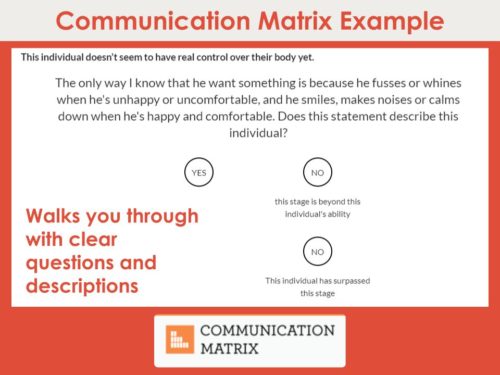
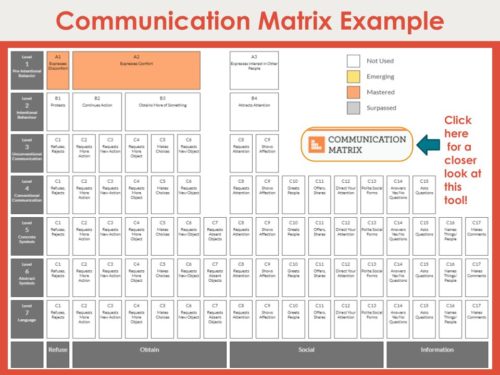

- The Assessment of Learning Process (ALP) for AAC
Authors: PRC-Saltillo is proud to have been part of the close collaboration between Lisbeth Nilsson, Chip Clarke and Sarah Wilds. (Adapted from the original ALP for Powered Mobility (Adapted from the original, developed by Lisbeth Nilsson and Josephine Durkin (Nilsson & Durkin, 2014; Nilsson et al, 2011)
Cost: FREE
ALP Website Description: “The Assessment of Learning Process (ALP) for AAC is a simple
clinical framework for understanding how someone learns an access method in AAC.
Regardless of access method – eye-tracking, switches, head tracking or touch – the ALP for AAC is applicable across low- and high-tech AAC options. In addition, the information gathered with the ALP for AAC provides a way to structure interventions to best match your learner’s current level of ability.”
Target Population:
-
- AAC users who use touch, switches, head tracking and eye-tracking.
- Individuals with complex bodies
- Individuals with complex communication needs
- AAC users from novice to expert
Key Features:
-
- Describes 3 broad stages of learning (across 8 phases – novice, curious novice, beginner, advanced beginner, sophisticated beginner, competent, proficient, expert)
- Explores 5 areas of assessment:
- Activity & Movement with AAC Device
- Understanding of AAC device use
- Attention
- Social Interaction
- Expressions/Emotions
- Offers single-page guides that are downloadable from the ALP website
- Provides a framework for understanding progression in AAC access learning

![]()
Developed by Tobii Dynavox in conjunction with Dynamic Therapy Associates of Kennesaw, GA. (2014)
Cost: FREE
DAGG-2 Website Description: “Use the Dynamic AAC Goals Grid-2 (DAGG-2) as a systematic means to assess (and reassess) an individual’s current skills in AAC and to assist in developing a comprehensive long-reaching plan for enhancing the AAC user’s communicative competence. This tool strives to assist with the team’s consideration of the myriad of components that make for successful AAC use.”
Target Population:
-
- Children and adults
- Anyone using or learning to use AAC
Key Features:
-
- Checklist format
- Can be completed online or printed and filled in by hand
- Assesses: Understanding, Expression, Social Interaction, Literacy Skills, Other
- Provides a Chain of Cues for each goal (least to most hierarchy – goal met, natural cue, indirect cue, direct verbal cue, direct pointer cue, physical assistance)
- Allows measurement of progress and movement along the described Ability Level Continuum (Emergent, Emergent-Transitional, Context-Dependent, Transitional Independent, Independent)
- Can be used for initial assessment or progress monitoring
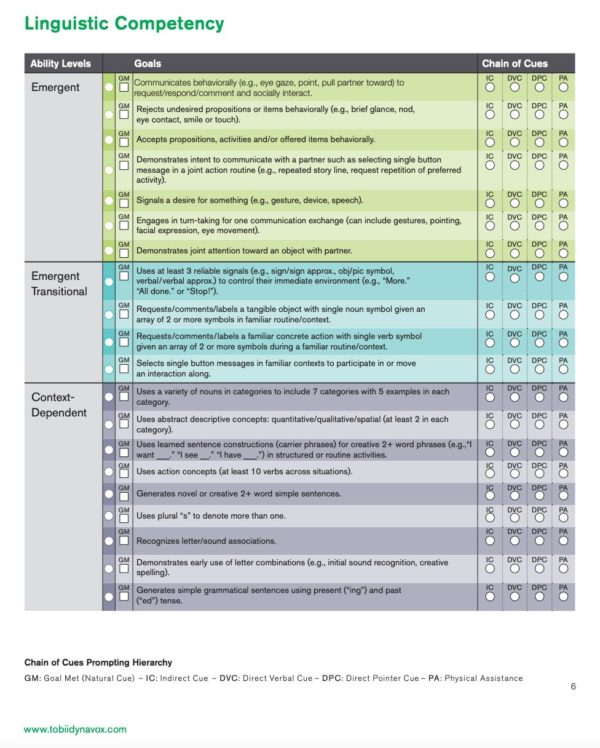
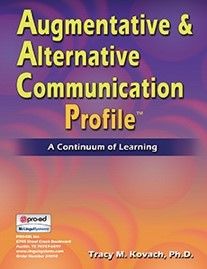
Augmentative & Alternative Communication Profile Website Description: “The Profile has two functions:
-
- “An assessment tool that measures subjective, functional skills for developing communicative competence using AAC systems; re-evaluates skill level; and monitors progress.
- A guide to help manage clients who use any type of speech-generating AAC system. The profile grew out of the literature related to critical pathways and continuums of care implemented to increase quality of care and efficiency and to reduce costs.”
Author: Tracy M. Kovach, Ph.D.
Cost: $80.00 (includes Examiner’s Manual and 15 Profile Forms)
Target Population:
-
- Ages 2-0 through adult
- Originally developed for use with children who use speech-generating systems
- Appropriate for use with adults who do not have acquired communication disorders and who use AAC systems
- Not specific to a disorder, severity, or setting.
Key Features:
-
- Checklist format
- Assessment items are divided hierarchically into ability-based levels called Skill Set Levels within the four Communicative Competencies (Light, 1989)
- Helps identify areas of strength and those that need intervention and instruction
- Helps determine functional, long-range outcomes and the steps toward achieving them
- Allows comparison of individual performance over time
- Helps identify ways that AAC support team members can define and coordinate their roles for intervention and instruction programs
- Helps identify and provide optimal learning environments
- Operational skill items consider level of partner skill
The Quad Profile: Checklists for Profiling Language Samples Description: “The QUAD© Profile is a simple analysis tool that allows you to take a sample of language and compare it against a set of checklists. The checklists look at four levels of language. The profile does not give a score and is not intended to do so. However, there are some norms provided so you can get a general idea of where a client is succeeding or having difficulties.”
Author: Russell Cross, BSc. (Hons.) DipSCT, MRCSLT
Cost: FREE
Target Population:
-
- Can be used with children or adults
Key Features:
-
- Checklist format is intended to provide a snapshot of an AAC user’s abilities
- Simple analysis tool that allows you to take a language sample and compare it against a set of checklists.
- Vocabulary
- Morphology
- Syntax (Sentence Types)
- Language Functions
- Helps identify strengths and weaknesses
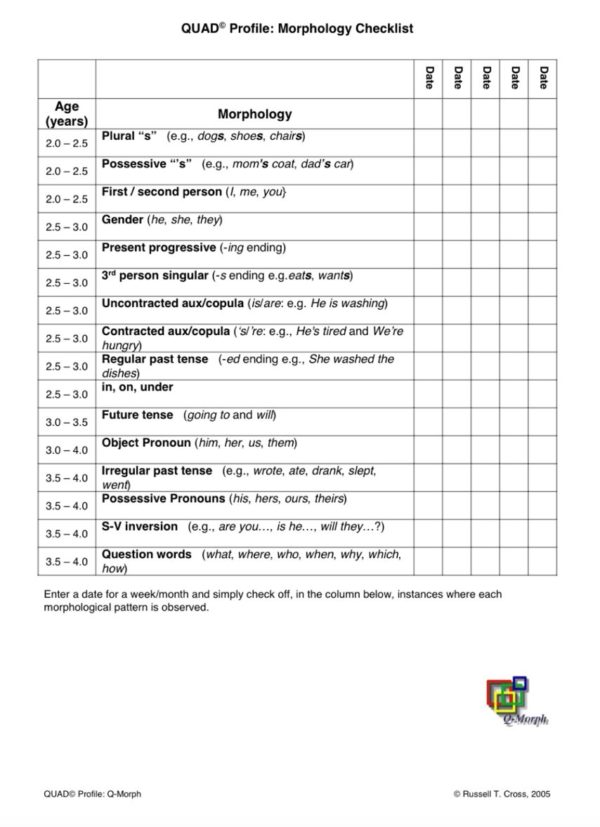
Author: PRC-Saltillo
Cost: $19.95/year subscription to AAC Language Lab includes access to language charts
Target Population:
-
- Children or adults
Key Features:
-
- Visual way to see where an individual falls now and what skills come next
- Helpful to circle student’s current skill level and use the charts to determine logical next steps
- Color-coded
- Subscription Includes charts for
- Parts of speech
- Pragmatics
- Morphology
- AAC language stages
- Sentence types
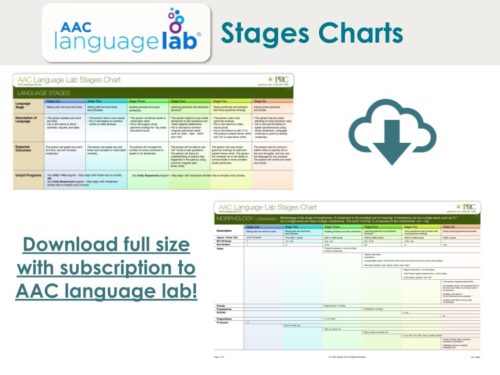
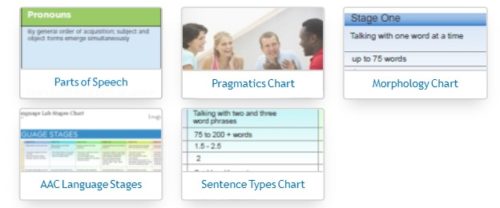
- Language Sample Analysis An excellent, but often missed tool for selecting and monitoring goals for AAC users is the “good old” language sample!
Target Population:
-
- Can be used with children or adults who have begun to use AAC
For helpful information and guidance on using language samples to inform the AAC Goal Creation Process, be sure to check out the following resources:
-
- PrAACtical AAC blog post – Word Count: Looking at AAC Language Samples by Dr. Carole Zangari]
- Tool for Analysis of Language and Communication (TALC) (Senner & Baud, 2013)
- Writing IEP Goals and Objectives for Receptive and Expressive Communication for Children with Complex Communication Needs Handout by Linda Burkhart and Gayle Porter
- Upcoming Minspeak webinar by Gail VanTatenhove, PA, MS, CCC-SLP: Language Sample Collection and Analysis with People who Use Minspeak Systems (July 7, 2022, 7:00-8:30 PM EST; https://minspeak.com/webinars/)
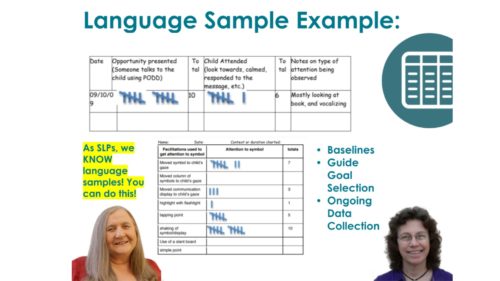
It’s wonderful that we have so many excellent tools to help us (1) identify where our AAC learners currently fall in their journey to communicative competence and (2) determine logical and developmentally appropriate skills to target next. Exploring each of these tools and finding those that best meet your needs can really bolster your AAC assessment and AAC goal writing toolboxes. Thank you to the creators of these excellent and easily accessible tools!
Stay tuned! In the next installment of this series, we will begin to explore how to craft AAC goals that are both measurable and transparent to all team members (including families).
References
Ahern, K. (2014, April 8). Meaningful and evidence-based goals – part one AAC. Retrieved October 11, 2021, from http://teachinglearnerswithmultipleneeds.blogspot.com/2014/04/meaningful-and-evidence-based-goals.html.
Blackstone, S. W. & Wilkins, D.P. (2009). Exploring the Importance of Emotional Competence in Children with Complex Communication Needs. In: Perspectives on Augmentative and Alternative Communication, 18, 78-87.
Burkhart, L, & Porter, G. (2019). Writing IEP Goals and Objectives for Receptive and Expressive Communication for Children with Complex Communication Needs. From the PODD Communication Books Advanced Workshop Manual.
Light, J. (1989). Toward a Definition of Communicative Competence for Individuals Using Augmentative and Alternative Communication Systems. Augmentative and Alternative Communication, 5, 137–144.
Light, J.C., Beukelman, D.R., & Reichle, J. (Eds.). (2003). Communicative Competence for Individuals who Use Augmentative and Alternative Communication. Baltimore: Paul H. Brooks Publishing Co. Sarah W.
Light, Janice & McNaughton, David. (2014). Communicative Competence for Individuals who require Augmentative and Alternative Communication: A New Definition for a New Era of Communication? Augmentative and Alternative Communication. 30. 1-18. 10.3109/07434618.2014.885080.
:::::::::::::::::::::::::::::::::::::::::::::::::::::::::::::::::::::::::::::::::::::::::::::::
You can learn more from Lauren here.
Lauren S. Enders, MA, CCC-SLP is a licensed and ASHA certified Speech-Language Pathologist working as a school-based Augmentative and Alternative Communication and Assistive Technology (AT) Consultant for Bucks County Intermediate Unit in Bucks County, Pennsylvania. She has had a passion for using AAC and other forms of assistive technology to support students with complex communication needs and complex bodies since she began her career in 1995. Lauren presents regularly at national conferences including Closing the Gap, ATIA, and ASHA as well as more intimate conferences, speaking engagements, and webinars. She has shared her knowledge via blog posts on PrAACticalAAC.org and USSAAC’s Speak Up blog as well as articles published in the ASHA Leader and Closing the Gap Solutions Magazines. Lauren enjoys sharing AAC and AT-related resources and networking with others in the field via Facebook, Pinterest, Twitter, Instagram, and Scoop.It.
Filed under: Featured Posts, PrAACtical Thinking
This post was written by Carole Zangari
